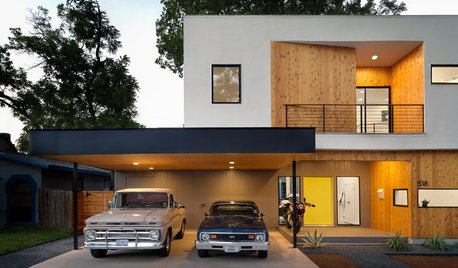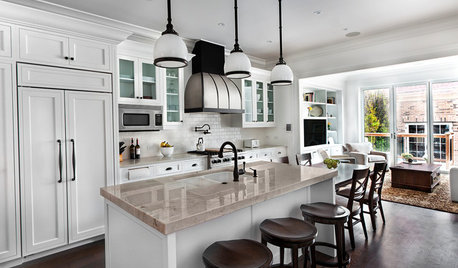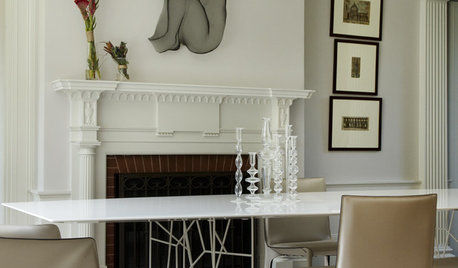A long time ago, I gained a nugget of wisdom from a professor of horticulture. He said that every answer to a horticultural question should first be prefaced with, "Well that depends." This is a truism because any number of variables can render the perfect answer useless under different circumstances. A similar conundrum often exists in the midst of advice dealing with questions about landscape design.
Lately we have had a number of threads dealing with the proper (good, better, best) choice of hardscape materials. In deference to the wonderful examples of Michelles work, there are many homes where these kinds of materials would be inappropriate. Im also sure that Michelle would be the first to agree because I am talking about materials, not concepts or ideas. For example, I will be installing a new patio this fall and will be using pavers. Cost is really not the issue as much as it is appropriateness. In my specific instance, a patio installation that would, literally, cost two to three times the total value of the house would look quite silly wonderful but still silly.
Is stone a superior material? Certainly. However, there are places where it is generally inappropriate; namely places where stone rarely exists. Historically, because this area of the country had such a dearth of stone to use as a building material, the builders of mansions in these parts became famous for their carpentry skills, which resembled stone elements of architecture. In other parts of the country, stone was the obvious building material of choice but what are you going to do if you dont have any? Of course, with modern transportation, availability is no longer an insurmountable problem. However, there remains a long historical tradition in this region of using materials other than stone.
Laying a patio that, several times, exceeded the cost of my house would be akin to Bob Guccione walking into that Cheyenne, Wyoming courtroom wearing velvet pants, silk shirt opened to his waist and a ton of gold necklaces and bracelets that jangled whenever he moved and facing trial lawyer, Gerry Spence, wearing his trademark fringed buckskin jacket. Guccione was almost laughed out of the courtroom by the jury. In my residential development, pavers are very upscale. An ostensive display of Chinese slate would have the neighbors thinking that I might be one of those guys that wears a thong and it is way too tight!
I know that a lot of choices ultimately boil down to personal likes and/or dislikes. After all, that is why they offer the same car in different colors. On a personal level, I embrace this Midwestern land which has blessed several generations of my family. Like it or not, stone is not an element commonly encountered here. I desire incorporating materials that compliment, not upstage, my predominantly native prairie plantings. I hope to achieve a subtle, welcoming elegance that embraces this community. I also want an attractive patio surface that slightly exceeds many neighbors (In their opinion, "really nice".) cement slabs. However, there are regionally acceptable limits. And yes; your region and neighborhood may hold quite different values.
I have previously shared photos of my paver walkway leading to my front door. I intend to use these same materials to construct my patio. I am again incorporating handicap accessibility into the design so that a wheel chair can easily enter my home from either the front door or this new patio at the rear of the house. I have given much thought to the choice of materials. As many of you can probably tell from the tone of previous postings, I am not an advocate of either sloppy or cheap. However, I am an advocate of appropriate. I think it would be inappropriate to feature a stone patio when what I am really trying to feature is the underappreciated, inherent beauty of the prairie and its unique flora.
IronBelly

















mich_in_zonal_denial
jake
Related Discussions
Thinking about a Simplicity Conquest Mower
Q
'David' keeps dying?!
Q
I think we've chosen a granite!
Q
HELP! TILE HAS LIMITED MY WALLPAPER CHOICED
Q
Brent_In_NoVA
Ron_B
inkognito
ironbelly1Original Author
ilima
karinl
laag
ironbelly1Original Author
inkognito
GingerBlue
ilima
karinl
Karen Mickleson
mich_in_zonal_denial
Karen Mickleson
karinl
ilima
laag
karinl
mich_in_zonal_denial
punamytsike
GingerBlue
karinl
Karen Mickleson
Brent_In_NoVA
kategardens
inkognito
donnaz5
Frankie_in_zone_7
karinl
Saypoint zone 6 CT
GingerBlue
mich_in_zonal_denial
ilima
laag
sammie070502
gardenscout
inkognito
duluthinbloomz4
timbu
inkognito
timbu
wellspring
gigiwigi
timbu
missmary - 6b/Central Maryland
annieinaustin
timbu